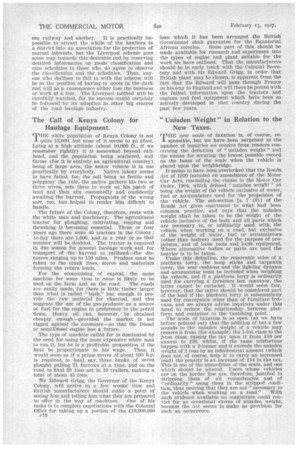The Call of Kenya Colony for Haulage Equipment.
Page 40

If you've noticed an error in this article please click here to report it so we can fix it.
THE white population of Kenya Colony is not quite 13,000, but none of it seems to go afoot. Lying at a high altitude (about 10,000 ft., if we remember rightly) it is somewhat beyond railhead, and the population being scattered, and farms (for it is entirely an agricultural country) being of large area, the motor vehicle is in use practically by everybody. Native labour seems to have failed, for, the soil being so fertile and polygamy the rule, the native gathers his two or three wives, sets them to work on his patch of land and then sits contentedly and confidentjy awaiting the harvest. Propaganda of the wrong sort, too, has helped tO render him difficult to handle.
The future of the Colony, therefore, rests with the white man and machinery. The agricultural tractor for ploughing, cultivating, reaping and thrashing is becoming essential. Three or four years ago there were 40 tractors in the Colony; to-day there are 1,600, and in a year or so that number will be doubled. The tractor is required in due season for general haulage work and for transport of the harvest to railhead—the distances ranging up to 150 miles. Produce must be taken to the trunk lines, stores and materials forming the return loads.
For the economizing of capital, the same machine for some time to come is likely to be used on the farm and on the road. The roads are easily made, for there is little timber larger than what is called "bush," but enough to provide the raw material for charcoal, and this suggests the use of the gas-producer as a source of fuel for the engine in preference to the petrol drum. Heavy oil can, however, be obtained cheaply enough—provided the market is not rigged against the consumer—so that the Diesel or semi-Diesel engine has a future. • The type of machine called for is dominated by the need for using the more expensive white man to run it, but he is a profitable proposition if the haul be proportionate to his wage. Thus, it would seem as if a prime mover of about 100 h.p. is required, to haul, say, three banks of seven ploughs pulling 21 furrows at a time, and on the road to hhul 30 tons net in 10 trailers, making a total of about 45 tons.
Sir Edward Grigg, the Governor of the Kenya Colony. will arrive in a few weeks' time and British manufacturers should make a point of seeing him and telling him what they are prepared to offer in the way of machines. One of his tasks is to complete negotiations with the Colonial Office for taking up a portion of the £10,000,000 c18 loan which it has been arranged the British Government shall guarantee for the Equatorial African colonies. Some part of this should be made available for research and experiment into the types of engine and plant suitable for the work we have outlined. That the manufacturers should he in early touch with the Colonial Secretary and with Sir Edward Grigg, in order that British plant may be chosen, is apparent from the fact that Sir Edward will pass through France on his way to England and will there be posted with the fullest information upon the tractors and engines and fuel equipment which have been so actively developed in that country during the past few years.












































































































